Overlock feet: selection and operation
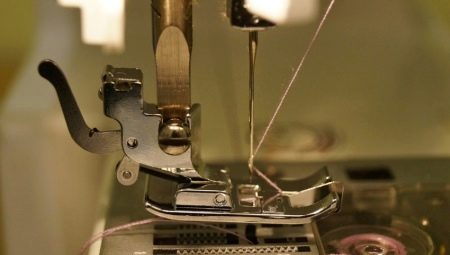
A few decades ago, clothes purchased in a store differed significantly from those that were sewn at home. The difference was in the quality of the seams. At home, at that time, it was impossible to smoothly and beautifully sweep the edges of the finished product.
Today, almost all modern sewing machines can easily cope with this task. In the end, all the seams are not only neat, but in addition to everything they almost never crumble. In order for the work to go like clockwork, the seamstress needs such a detail as an overlock foot, which can be easily installed on almost any sewing machine.

What does the foot look like?
Not every seamstress can afford to purchase an overlock. It is quite expensive and seems like a disadvantageous investment to many, especially if the seamstress works from home. Therefore, seamstresses instead buy an overlock foot intended for a sewing machine. It is used for overcasting seams of finished products.
One of the main features of the overlock foot is the presence of a strap, which helps to lengthen the overcasting thread.
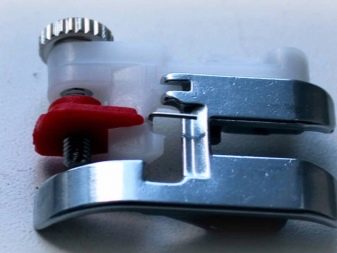

In addition, it has a "spreader", with the help of which it is possible to avoid the contraction of the edge of the matter. And also such the foot has a limiter pressure plate, which is intended for overlock stitching, that is, for laying the most even seam. But the plate guide is used in order to properly separate the edge of the material being processed. During operation, the needle punctures both the right and left sides of the pressure plate. And it seems that she is braiding this plate with a thread. Therefore, the material does not shrink. Some models of overlock feet may be equipped with a knife.They not only overcast the fabric, but also cut off everything that is unnecessary.


Advantages and disadvantages
Like any other part, the overlock foot has its pros and cons. First, you should familiarize yourself with its merits.
- The edges of the fabric at the end of the work are very neat and even. In addition, they do not shrink, which is very important when working with fabrics such as knitwear, tulle or chiffon.
- With the help of such a detail, it is possible to get fairly high-quality finishing lines.
- Since the foot has a guide, the edge is overcast nicely and evenly.
- With this foot it is possible to sew a hem seam.
- Blind hemming is done better.
- Installing the overlock foot on the clipper is very easy. Therefore, even a beginner can cope with such a task.



The disadvantages of such a device include a number of points.
- Not all sewing machine models can be fitted with the overlock foot. Therefore, when buying, be sure to pay attention to the presence of instructions. It should indicate whether it is possible to install such a part. If there is no such option, then the seamstress will have to buy an overlock or simply purchase an adapter.
- When overcasting the edges of knitted fabrics, the seams do not always retain their elasticity.
- In order for the final work to be of high quality, it is necessary to very carefully select both the size of the threads and the thickness of the needle. Otherwise, it will be very difficult to achieve a good result.
- Compared to the overlocker, the presser foot design is not designed to withstand too heavy a load.


How to choose
The overlock foot can be supplied with the sewing machine. However, in many trim levels it is not. In this case, such a part can be purchased separately in a specialized store or ordered via the Internet.
When buying, be sure to pay attention to its compatibility with the existing sewing machine. If there is no such model, then it is worth purchasing a special adapter.
It can only be found in specialized retail outlets.


In addition, it is worth noting that there are feet that are designed for household and industrial sewing machines. They differ from each other, and this should be taken into account when buying. So, for a machine intended for home use, you can buy a foot made of plastic. Whereas for industrial machines, you should opt for parts made of metal. After all, the load in factories is much greater than at home. Therefore, the plastic foot simply cannot withstand them.
For example, a model such as Janome part most often used so that you can sew on a rubber band, the width of which is in the range of 4-7 millimeters.
Those who wish to protect matter from contraction should turn their attention to overlock foot AstraLux.
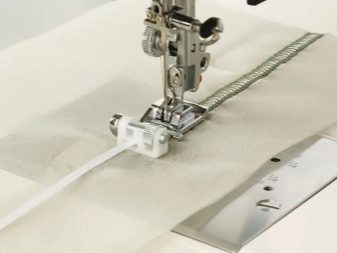

In the event that a seamstress wants to simultaneously grind parts and overcast their edges, you need to pay attention to such a foot as Family. These parts are best suited for Janome sewing machines.
In order to overlock a blind seam, you need to opt for such a foot as Jaguar. Seamstresses, who very often use denser fabrics, need to take a closer look at the overlock foot. "G" AU-164. It is suitable for sewing machines such as Singer or Brother.

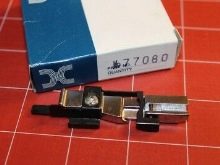

Those who prefer to use decorative finishing stitching on their products should opt for the foot Juki A9821.
However, most seamstresses turn their attention to the overlock foot. with a side knife or, as it is called in other words, a side cutter... Indeed, with its help, you can simultaneously sew parts and overcast their edges. In addition, it is suitable for both domestic and imported sewing machines.

How to use
Before you buy an overlock foot for yourself, you need to learn how to work with it.Initially, the seamstress must learn the theory, and only then proceed to practical exercises. First of all, you need to learn how to connect together all the cut details of the future product. After that, you need to understand how to align the allowances, and the excess matter and threads that stick out, be sure to learn how to trim with scissors.


Next, you can start installing the foot itself on the machine. To do this, you need to detach the regular foot. To do this, raise the presser foot lifting lever and remove the part installed during production. After that, the overlock foot must be placed directly under the holder, and then lower the lever so that the holder immediately slams on the axis of the part to be installed.
It can be used to sew an overlock stitch with a stitch width of up to 5 millimeters or a zigzag stitch with a stitch length of 3 millimeters.
After that, you need to try sewing, to make sure that when the needle is lowered, it does not touch the edges of the foot.






After that, you need to adjust the settings. First of all, this is the adjustment of the tension of the upper and lower threads. With its help, you can make the stitching as close to the edge as possible. This is of great importance for very delicate fabrics.
The choice of the required stitch is no less important. After all, using the overlock foot, you can make different seams.
- Reinforcement zigzag. With the help of such a seam, you can simultaneously connect the edges of the fabric, as well as overlock them. This allows the seamstress to save time and effort.
- Elastic seam more used for knitwear, as well as for woolen fabrics.
- Open double seam It is used for seaming non-stretch fabrics at the same time and for overcasting.
- Double closed seam is intended for various types of embroidery, for example, on an elastic band, on a very narrow ribbon. In addition, overcasting of a single fabric, as well as thicker types of fabric, for example, tweed, should also be included here.
- Oblique serrated seam most suitable for materials that are too thin. Many people use it to trim the edges of tablecloths.
- Moscow seam most often used for processing thin scarves, ruffles, cuts on dresses or skirts.
- Decorative stitches, which can be used not only on dresses, but also on blouses.

Anyway it is necessary to choose the type of stitch only after the foot is installed on the sewing machine. Another important point is the length of the future stitch. It depends entirely on the type of matter.
When the choice is finally made, put the fabric under the overlock foot so that its edges rest against the rib. Next, you need to make a test line, while controlling the direction. There is a protrusion on the sole of the foot, with the help of which the edge of the free thread is supported. Thanks to him, the overcast seam turns out to be beautiful and even. When working with such a foot, you must remember that you cannot pull the material. If you ignore this rule, the line will turn out to be uneven, in addition, unwanted gathers will appear on it.
Summing up, we can say that the overlock foot can handle a variety of tasks... The result of the work is usually impressive and pleasantly pleasing.
Therefore, do not underestimate the possibilities of this small detail, especially if the seamstress is working with small amounts of fabric.
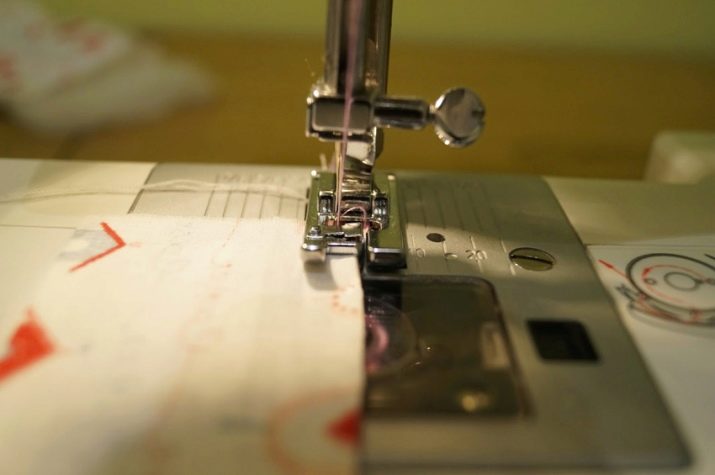
A short video review below is devoted to the overlock foot, designed for sewing overlock (overlock) seams on a household sewing machine.








